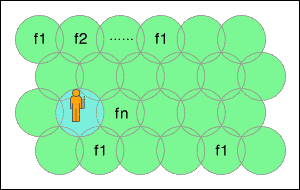Cellular Mobile Communication System -1.Outline
The concepts behind the repeated use of frequencies on a geographical basis for cellular systems were proposed by K. Bullington (Bell Laboratories) in 1953 and by H.J. Shulte (Bell Laboratories) in 1960. Kin-ichiro Araki (former Nippon Telegraph and Telephone Public Corporation) introduced the concept of wide-area location registration and small cells in 1968. V.H. McDonald (Bell Laboratories) re-proposed the "cellular system concept" in 1978 and introduced "cell splitting," in which cells are subdivided to meet increases in demand, and the "hand-over (hand-off)" concept. Practical systems were introduced throughout the world in the 1980s, with the adoption of particular systems in various countries.
In a cellular mobile communications system, the service area is divided into many small areas called cells. A cell station is installed in each, and tracking connections are carried out in accordance with the movements of the user. As users move across multiple cells in this system, it is always necessary to identify the cell in which the mobile station is located. The essential control technologies to smoothly continue communications as users move among cells are "location registration" and "hand-over."

The Concept of Cellular Systems
![]() Created 1999/03
Created 1999/03
